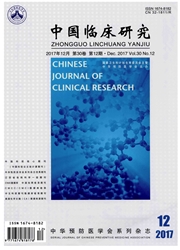

 中文摘要:
中文摘要:
目的 探讨非小细胞肺癌(NSCLC)表皮生长因子受体(EGFR)基因突变的临床意义,及EGFR抑制剂治疗的意义。方法 回顾性分析274例NSCLC患者的临床资料。提取肺癌组织DNA,通过PCR扩增及基因克隆进行基因检测,将测得序列与基因库中EFGR序列(NM005228.3)进行比较,分析EGFR基因突变类型及分布,并对EGFR抑制剂—小分子酪氨酸激酶抑制剂(TKI)治疗效果进行观察。结果 274例非小细胞肺癌患者的癌组织中共检出EGFR基因突变52例,基因突变率为18.98%,EGFR基因突变与性别及癌症分期相关,突变主要发生在女性、晚期患者。NSCLC患者EGFR基因突变主要发生于外显子18、19、20、21位点,其中发生EGFR-21 L858R替代突变占23.08%,EGFR-19缺失突变占21.15%。21例接受吉非替尼(TKI)治疗8例得到病情控制的患者中7例出现EGFR基因突变,余13例患者未发生EGFR基因突变。结论 EGFR基因突变对于NSCLC患者具有重要临床意义,NSCLC患者的EGFR基因检测对指导临床治疗有重要价值。
 英文摘要:
英文摘要:
Objective To investigate the clinical significance of gene mutations of epidermal growth factor receptor ( EG- FR) and the efficacy of tyrosine kinase inhibitor (TKI), a EGFR inhibitor, in patients with non-small cell lung cancer (NSCLC). Methods A retrospective analysis was performed on the clinical data of 274 patients with NSCLC. After extrac- ting the DNA of lung cancer tissue,the gene sequencing was made by polymerase chain reaction (PCR) amplification and gene cloning, and the measured sequence was compared the EGFR sequence of gene bank ( NM005228.3 ) to analyze the gene mutation types and its distribution. The effect of TKI therapy and its association with EGFR gene mutations were observed and analyzed. Results EGFR gene mutations mainly occurred in women and advanced NSCLC patients ( P 〈 0. 05, P 〈 0. 01 ) , namely,the mutations were associated with patients' sex and NSCLC clinical stages. Out of 274 cancer tissue samples,gene mutations were detected in 52 sample (gene mutation rate was 18.98% ). Gene mutations mainly occurred in loci 18,19,20 and 21 of exon,in which EGFR-21 L858R gene mutation accounted for 23.08% ;EGFR-19 deletion mutation accounted for 21.15%. Twenty-one patients received gefitinib (a kind of TKIs) therapy, and the disease was effectively controlled in 8 patients in whom the geue mutations were found in 7 cases ( 87.5% ), and the gene mutations were not found in the remaining 13 patients. Conclusion EGFR gene mutations have an important clinical significance for NSCLC patients. EGFR gene mutations were associated with therapeutic effect of TKI, and it might become a target for treatment of NSCLC.
 同期刊论文项目
同期刊论文项目
 同项目期刊论文
同项目期刊论文
 Increased trefoil factor 3 levels in the serum of patients with three major histological subtypes of
Increased trefoil factor 3 levels in the serum of patients with three major histological subtypes of 期刊信息
期刊信息
